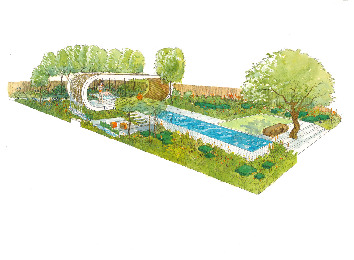CANCER RESEARCH UK – HELPING YOU TO REDUCE YOUR RISK AT THE CHELSEA FLOWER SHOW 2006
Cancer Research UK unveils plans for its 2006 Chelsea Flower Show Garden, designed by Andy Sturgeon and illustrating the charity’s major cancer prevention campaign, ‘Reduce Your Risk’.
The garden design is based around three key pillars of the initiative; Eat Healthily, Stay in Shape and Be SunSmart. These messages are at the core of Andy’s ambitious and breathtaking design for the Cancer Research UK Garden.
Half of all cancers could be prevented through changes in lifestyle, which would mean 135,000 less people in the UK being diagnosed with cancer every year.
Richard Sullivan, Director of Clinical Programmes and Centres at Cancer Research UK, said “We’re delighted to be returning to the Chelsea Flower Show for the fourth year. Andy has designed a truly stunning garden, which not only provides a fantastic spectacle for all those visiting the show but also communicates our key messages in helping people to reduce their risk of cancer.”
The garden is centred on a turquoise blue, infinity-edged swimming pool complete with Jacuzzi and shaded pavilion, which is a first for the Chelsea Flower Show. The overall feel will exude an exotic quality although the planting will use species associated with the UK climate.
The pavilion will be framed by tree trunks at the rear of the garden, which form the backdrop and will be under-planted in a modern woodland style, using large drifts of Polystichum, Lamium orvala and Libertia grandiflora. The front of the garden will use bold blocks of planting integrated with large square tables of neatly clipped yew from Germany and edible plants including large flowering blueberries from Devon, noteworthy for their antioxidant qualities and acknowledged as an excellent source of vitamin C. Herbs such as rosemary, oregano and chives will also add to the edible plant theme.
A simple ‘loop style’ coffee table has served as Andy’s inspiration for the loop bench and the pavilion. The bench will be made from concrete and the pavilion will be a similar shape but with a funky slatted screen to cast shade and protect those using it from the sun’s damaging rays. The finish will be of polished plaster.
The perimeter of the garden will be a unique screen of hardwood sticks made by British craftsmen, pitched at a uniform height of two metres and combined with soft planting of the native grass Deschampsia cespitosa and four different varieties of foxtail lilies in various shades of orange. Diamond sawn Indian paving stones in pale cream will add a crisp contemporary quality to the striking pathway through the garden and the lawn will be grown in one large piece and rolled out like a carpet. False acacia Robinia pseudoacacia at the front of the garden will act as a dramatic focal point and is sure to attract the attention of show visitors.
Cancer Research UK’s Chelsea Flower Show Garden 2006, designed by Andy Sturgeon, highlights the charity’s major cancer prevention campaign ‘Reduce the Risk’. The garden design is based around three key pillars of the initiative: Eat Healthily, Stay in Shape and Be SunSmart. The inclusion of structures in the garden such as the pavilion, which provides shade from the midday sun and Chelsea Flower Show’s first full-sized swimming pool for essential exercise help to illustrate the campaign.
Inspired by a retro styled curved bench the pavilion has been designed to offer shade and sanctuary from the hottest part of the day and echoes the style of the coffee table also in the garden. Lamisell, the company responsible for the spectacular Padstow Lifeboat Station in Cornwall, is manufacturing the curvy pavilion. The wooden structure is constructed from Glu-lam beams made from 62 individual layers of Douglas fir curved to an internal radius of one metre. The pavilion will be eight metres long and two and a half metres high, in twelve pieces and assembled on site in two days.
Furniture is an essential element for any stylish family garden, especially one such as this dedicated to outdoor family living, eating, exercising and relaxing whilst being protected from the sun. The bench at the front of the garden is called ‘Bench Bo’ made in France by designer Francesco Passaniti is one and a half metres long by 478mm high and made to exactly the same proportions as the pavilion but on a reduced scale.
Paola Lenti wave loungers in rich chocolate brown continue the curvaceous theme and provide a stylish and welcome place to sit after a swim in the Jacuzzi or the turquoise blue, infinity-edged swimming pool.
The lighting on the garden will focus solely on the swimming pool, which will be lit all the way down one side to provide a soothing cool blue glow at night. The moving water of the Jacuzzi will project light and ripples onto the underside of the pavilion and trees and bring the garden to life.
Another strong feature of an Andy Sturgeon garden is the fencing and this garden for Cancer Research UK is no exception. 7,000 metres of 15mm thick dowel has been used to create the funky fence which will form a back-drop for 14 tulip trees. The fence will be painted a dark charcoal colour to help the fencing work in combination with the Dechampsia cespitosa, whose upright flower stems are vertical like the dowel and the star plant Eremurus.
The garden boasts a totally unique water feature that flows from the roof of the pavilion and pours flat from louvre to louvre following and moving around the curve of building. The water creates an illusion of standing inside a waterfall and is visible from inside the building.
The garden paving is of honed Indian sandstone in creamy brown tones and will be used for the pathways and paved areas. On the side of the pool it is being used ‘back to front’ with the ribbed corduroy-like underside providing the cladding. The water will cascade gently down the ribbed stone catching the light and creating a mesmerising effect.
Andy’s design for Cancer Research UK creates a garden that is not only beautiful and creatively planted but also encourages healthy living outdoors. Gardening provides gentle healthy exercise, which the whole family can enjoy together.
Andy Sturgeon’s modern design for Cancer Research UK’s fourth Chelsea Flower Show garden will certainly be recognisable as a Sturgeon garden with his unique style of planting and signature geometric shapes. Andy has designed a garden that reflects and embraces the current Cancer Research UK ‘Reduce the Risk’ campaign that encourages ‘Healthy Eating’, ‘Staying in Shape and being ‘SunSmart’.
Plants are key to any garden and this one is no exception. Andy has selected plants and trees both new and old that offer shade from the sun, colour to lift the spirits and healthy foods such as blueberries (Vaccinum corymbosum). Herbs also appear in the garden and can be used for cooking and to aid digestion.
Every designer develops a hunch as to which plants are about to explode onto the horticultural scene and Andy’s tip for 2006 is the striking architectural Eremurus, otherwise known as the desert candle or fox tail lily. The Cancer Research UK Garden will feature up to 150 Eremurus in four varieties, Sahara’, ‘Pinokkio, ‘Moneymaker’ and ‘Cleopatra’. The latter is tipped to be the most talked about plant at the show.
For sheer dramatic impact Andy has selected Iris Superstition with its deep purple velvety standards and falls so dark it looks almost black. Also known as "Bearded Iris" they are outstanding for their unusual colour and vigorous growth habit. They are hardy, disease and drought-resistant plants, which are long blooming in late spring and early summer, with handsome green sword like foliage. Planted in drifts and clumps, these irises will add height to the planting scheme.
One of the low cover plants chosen is Euphorbia cyparissias ‘Fen’s Ruby’ with plum coloured new spring leaves that fade to blue-ish green aging to orange. ‘Fen’s Ruby’ has finer leaves than the species and scarcely looks like a euphorbia except for the flowers, but is a softly clumping little perennial offering ferny, almost fluffy groundcover for partial to full sun in a low-maintenance garden. It is ideal for disguising the fairly unattractive rhizomes of the Iris and keeps weeds at bay.
Keeping with the wine colour palate, Lysimachia atropurpurea ‘Beaujolais’ may just create a small stir as it could be its first outing at the Chelsea Flower Show. The plant has burgundy coloured flowers with three inch long pointy spikes and is low growing.
Andy’s love of foliage plants comes to the fore in the Cancer Research UK Garden where he will be using large squares of clipped yew, (Taxus buccata). The needles of the yew have yielded an important anti-cancer drug called Taxol, which is currently used to treat cancers of the breast, lung and prostate
Native grasses such as Deshampsia cespitosa will be used to maximum effect with the Eremurus along the boundary line and at the back with the feature screen. The flower spikes will peek provocatively above the grasses, adding colour and texture.
Salvia officinalis ‘Purpurascens’ (purple sage) will be used for its fabulous foliage and to create interest and contrast. It will be planted in low mounds and woven throughout this modern woodland style of planting – the colour works well with the dark purple of Iris superstition. For texture and architectural effect, plants do not come more textural than Eryngium giganteum (Sea Holly) which looks spectacular when used amongst fluffy grasses such as Stipa tenuifolia



